If there’s one person whose name I think of, who is forever intertwined with colourful flowers, it’s Frida Kahlo. Famous for her floral headpieces and Mexican folk dresses that became her trademark, and her art all tell deep routed stories of her life. Though this post isn’t about flowers, it’s impossible not to admire Frida’s deep connection to them—their vibrancy, their fragility, and their ability to symbolize life and resilience.
Recently, while in Mexico City, we revisited the Frida Kahlo Museum, also known as La Casa Azul (The Blue House). This was my second visit in five years—the first was with my daughter, just before the world shut down with the COVID-19 pandemic.
Nestled in the leafy neighbourhood of Coyoacán, a half hour drive from Mexico City's bustling downtown, La Casa Azul was both Frida’s childhood home and her shared sanctuary with Diego Rivera. Hidden behind a cobalt blue wall the modest sized home with a good sized garden generously offers a vibrant, intimate glimpse into Frida’s life, with every corner blooming with her personality, passions, and pain.
While photography restrictions meant I couldn’t capture every detail (and, truthfully, some rules were confusing), and for privacy and security reasons I’m not able to share inside photographs. Thankfully, I managed to photograph a few garden scenes there to give you a taste of its magic.
A Walk Through Frida’s World
The museum is a fascinating timeline of Frida’s life and a treasure trove of Frida and Diego’s personal belongings—furniture, photographs, sculptures, and artwork that speak of their lives together. Frida and Diego would entertain the influential and famous here at home and in the garden, including US vice president Nelson Rockefeller and pianist George Gershwin.
Walking through the museum, you’ll find echoes of Frida’s life everywhere. Her iconic wardrobe and jewelry, displayed alongside her crutches and steel corsets, stark reminders of her physical challenges. Her four-poster bed, with the mirror her mother installed so she could paint while lying down, still holds her essence. Even her ashes, are said to be housed in an urn atop a dresser altar, keep her presence tangible.
The home is an ode to Frida’s unique relationship with colour. The kitchen, my favourite room for example, is a burst of sunshine with blue and yellow tiles, green doors, hand-painted earthenware pots and sunflower yellow painted floor. Her art studio, bathed in natural light, offers a serene view of the gardens, where she often sought inspiration. Frida’s wheelchair, easel, paints and reference books still where she left them. The kitchen reflects the warmth of daily life, while her studio brims with the tools of her creativity. Every room is a celebration of her spirit, blazing with the same bold colours she wore, painted, and surrounded herself with.
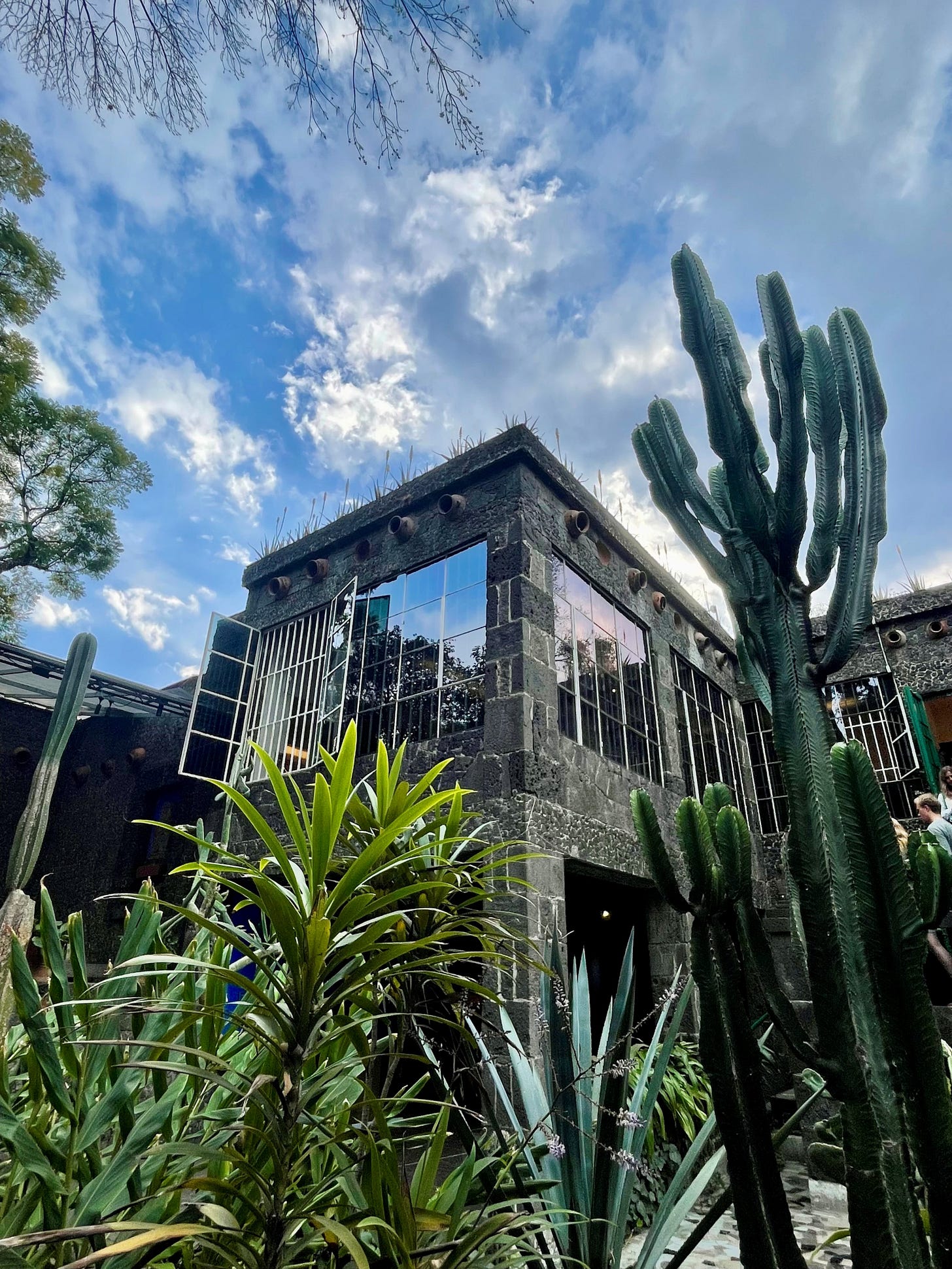
The gardens themselves feel alive with stories. Once home to Frida’s beloved menagerie of animals—parakeets, dogs, monkeys, deer, cats, and geese—the space features lush greenery, and sculptures where she would spend a lot of time resting and seeking respite.
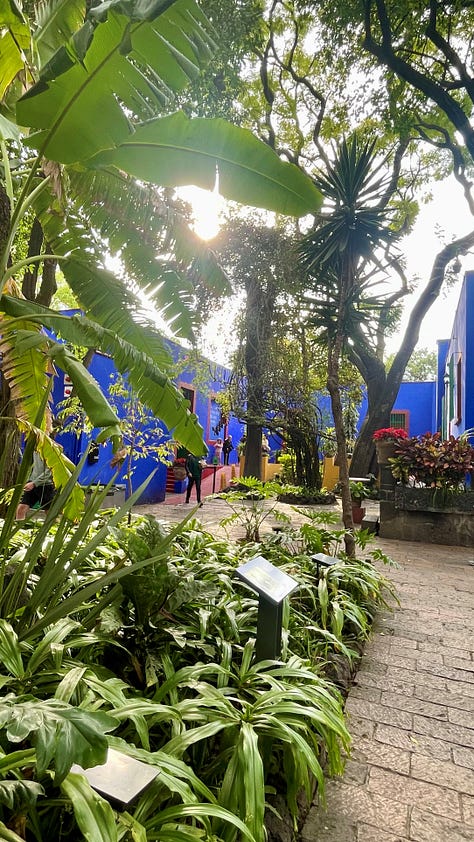
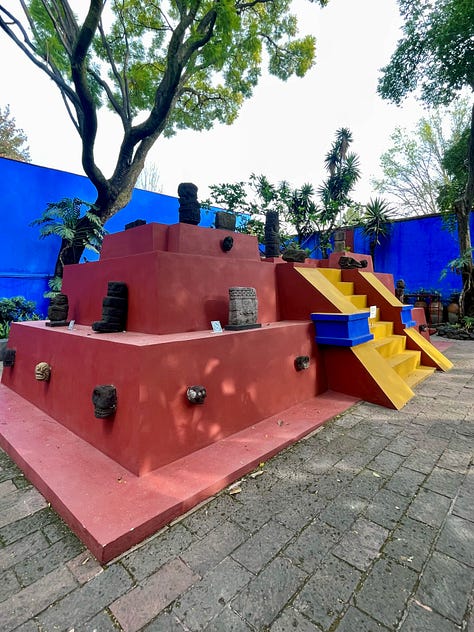
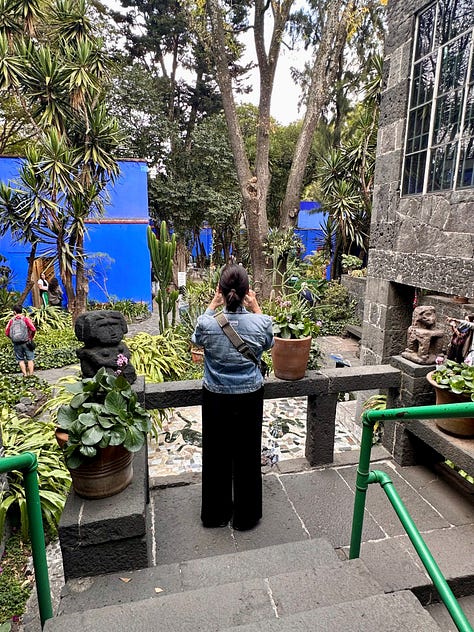
A Life of Beauty and Pain
Born on July 6, 1907, Magdalena Carmen Frida Kahlo Calderón grew up in Coyoacán, Mexico City, as the third daughter of the Kahlo Calderón family. Her life was marked by her creative art and hardship. At six, she contracted polio, leaving her with one leg shorter than the other and a limp. At 18, she was involved in a devastating bus accident breaking her shoulder, leg, pelvis and ribs and damaging her stomach and womb. This left her with lifelong back pain and physical challenges. But out of these struggles, Frida found her passion for painting, transforming her suffering into art.
Frida’s marriage to Diego Rivera when she was 20 years old (and he 40 years), was another tapestry of contrasts. Her mother famously described their union as “an elephant marrying a dove.” Together, they navigated love, infidelity on both sides, and artistic triumphs. Rivera was a prominent Mexican painter himself and who established the Anahuacalli Museum in Mexico City for his collection of pre-hispanic art. Though they divorced in 1939, they remarried a year later, continuing a complex partnership marked by both independence and deep connection.
In 1954, at age 47 Frida died in a room in the upper floor of the home. Cause of death was recorded as pulmonary embolism, however no postmortem was performed and research indicates possible suicide or drug overdose. In 1957 Rivera donated the home and all its contents into a museum in Frida’s honour. The museum is administered by way of a trust and the Bank of Mexico.
Her art, often deeply personal, reflected her struggles with health, miscarriages, heartbreak, political views and cultural identity. Through vivid colours and raw imagery, she painted her pain, her culture, and her love for life.
Practical Tips for Visiting
If you ever find yourself in Mexico City, I can’t recommend a visit to La Casa Azul enough. It is one of the City’s most popular museums. Be sure to book tickets in advance, especially during busy tourist seasons, as they often sell out quickly. Guided tours are available, and most exhibits have descriptions in both Spanish and English. There’s a museum shop, where you can pick up Frida-inspired memorabilia, from jewelry to art books, and enjoy a quiet moment in the café.
Frida Kahlo’s life was as layered as her art, as colourful as her gardens, and as enduring as the flowers she loved. Visiting La Casa Azul feels like stepping into the heart of a woman who lived boldly, despite the thorns life handed her.
If you can’t attend, or want to see my favourite rooms and the lush garden, check out https://www.museofridakahlo.org.mx where you can take a virtual tour of the entire museum. So go, wander through her world, and let her story bloom in your own heart.


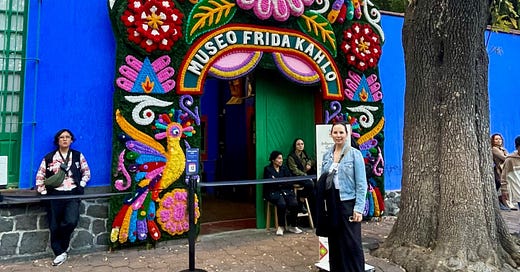



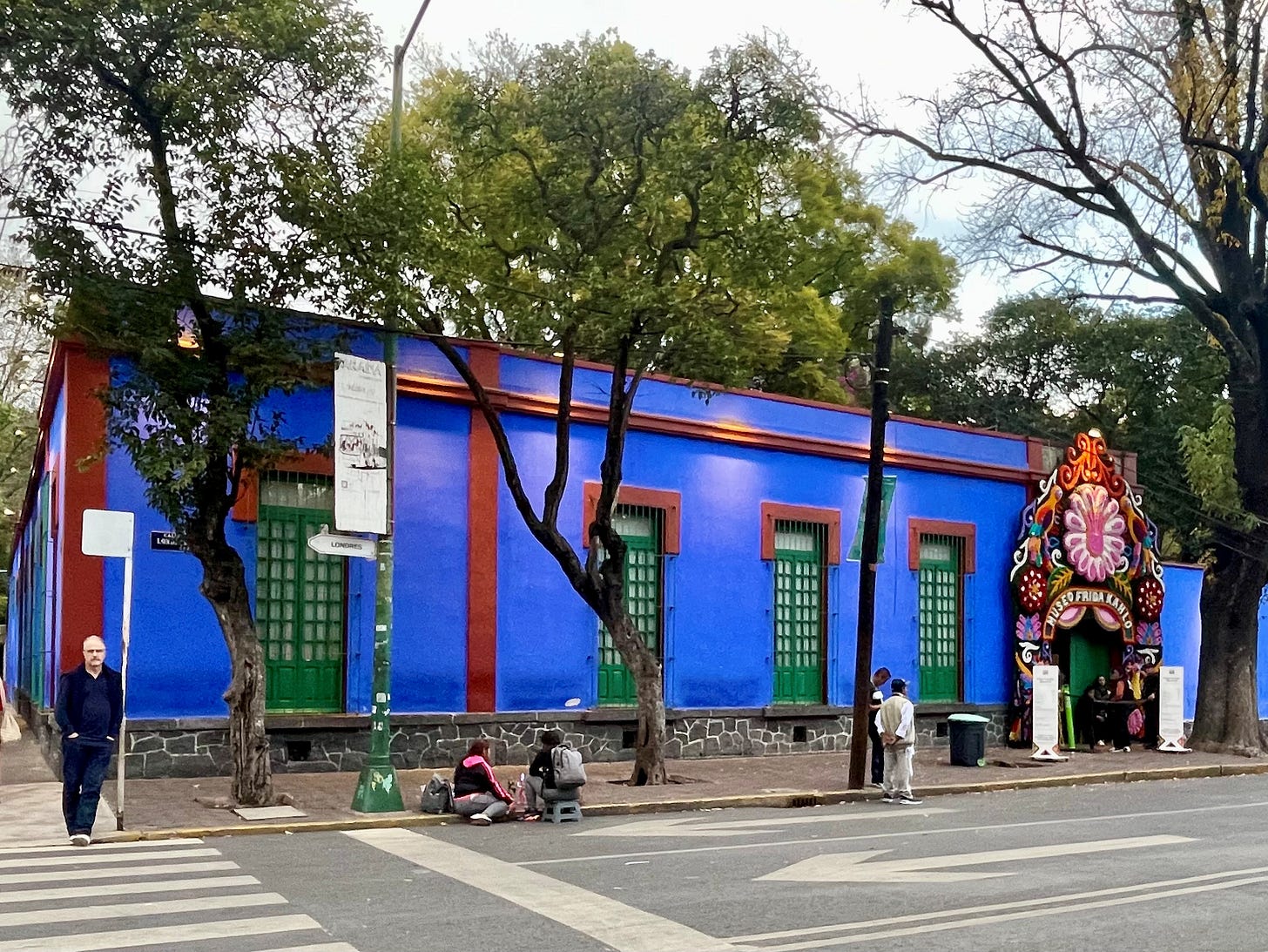



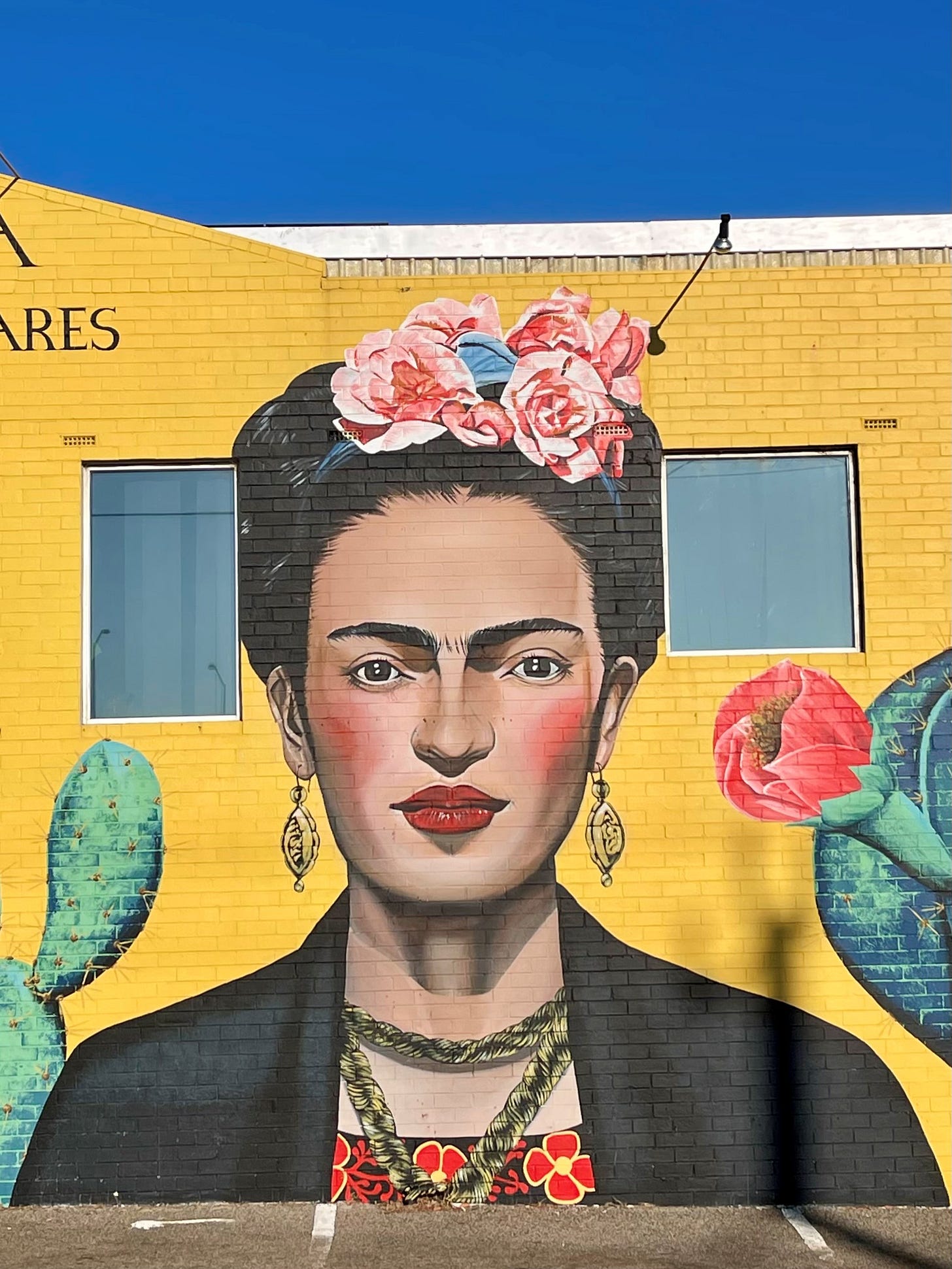




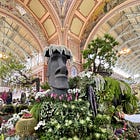

This is delightful! Thanks for such a fun piece.